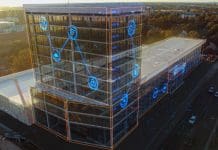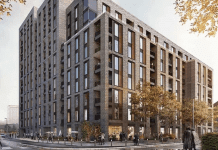Tom Saunders, senior researcher and Peter Baeck, Principle Researcher at Nesta detail how The Internet of Things has great potential to transform cities
The Internet of Things and its more abstract cousin the smart city has great potential to transform how cities are run. Yet despite the huge sums invested in smart bins, smart streetlights and city-wide sensing pilots worldwide, there is little evidence these technologies have helped city governments address issues that they or their citizens face. Innovate UK’s recently launched £10m Internet of Things cities demonstrator 1 competition could go a long way towards helping to generate this evidence. With its goal of creating a model for the future development of smart cities in the UK and internationally, what should the pilot focus on?
Over the last 2 decades the label ‘smart city’ has been applied to a family of technologies that can speed up the flow of things around the city and reduce the physical frustrations of urban life – free flowing traffic instead of jams; smart flows of energy and less waste; public services better targeted where they are most needed. Advocates of this top down approach to the smart city have often faced criticism: for being too concerned with hardware rather than with people; too focused on finding uses for new technologies rather than finding technologies that can solve pressing problems; and for emphasising marketing and promotion at the expense of hard evidence and testing solutions out in the real world.
In Nesta’s recent report, ‘rethinking smart cities from the ground up 2,’ we argue that successful smart cities of the future will combine the best aspects of technology infrastructure while making the most of the growing potential of ‘collaborative technologies’, technologies that enable greater collaboration between urban communities and between citizens and city governments. Based on our report, we offer cities that want to run Internet of Things pilots the following 5 recommendations on how to make this happen:
Set up a ‘smart citizen centre’ to drive innovation in collaborative technologies
Alongside investment in hardware projects, pilots should explore the potential of the Internet of Things to enable greater collaboration with citizens. To do this, the pilot should set up a ‘smart citizen centre.’
One of the primary goals of the centre should be investing in and testing ‘collaborative technologies’, with a focus on 4 emerging methods that are helping city governments engage and enable citizens: the collaborative economy, crowdsourcing data, collective intelligence and crowdfunding. The centre should be used to generate and share evidence with other cities for the most effective ways to engage citizens. The Seoul Innovation Bureau, and the Boston Mayor’s Office of New Urban Mechanics (MONUM) are 2 examples of how the centre could work.
Use open data and open platforms to mobilise collective knowledge
Internet of Things pilots around the world are evolving from a closed, proprietary model, for example Santander’s sensing pilot 3, to one based around modular platforms and open specifications, such as Chicago’s Array of Things 4 project. This can potentially make Internet of Things pilots much cheaper as well as include a more diverse set ideas from a range of organisations. To achieve this cities should: Ensure that all hardware and software generated throughout the pilot is open source and open specification, so that other cities can learn from and build on the results of this pilot. Where possible, the pilot should build on existing open source projects, such as the planning software built by Open Plans, rather than developing proprietary tools from scratch.
Open up problem solving to citizens, using online tools that let people debate ideas and decide which of them get implemented. Better Reykjavik is an example of how to do this. Challenge prizes are another way to gather ideas from citizens about the issues that are most important to them. They offer a powerful incentive for meeting a specific challenge, and can help stimulate new ideas for some of the most difficult challenges that cities face.
Make all data from sensors open to the public to help generate innovative solutions to urban challenges. Once the data is released, pay attention to finding productive uses for the data. For example, the Open Data Challenge series, a project by Nesta and the Open Data Institute brings businesses, community groups and city governments together to develop new ways of using city data.
Take human behaviour as seriously as technology
The smart city vision often fails to recognise the role that behaviour and culture play in the way cities work. Yet unsustainable patterns of living – such as the heavy use of resources or private transport – undermine data and technology–led efforts to make cities more sustainable. City governments should explore how the Internet of Things could be used to promote what is known as the collaborative economy, where people can access the things they need, but only occasionally use, from cars to power tools and gardening equipment. City governments should look to the example of Seoul, which has supported a range of collaborative economy initiatives.
Invest in smart people, not just smart technology
Without the ability to interpret data and understand how and why it is collected, there is a serious risk that it will be misinterpreted or ignored by city government employees. City governments should invest in training to give all staff a baseline understanding of data handling as well as hiring data specialists with advanced skills. Internet of Things pilots should also invest in digital skills for citizens. Successful programmes include: CoderDojo, a global movement of community– based programming clubs for young people, and ‘hackathons’ organised by the Singapore Government, which teach people how to use open data.
Spread the potential of the Internet of Things to all parts of society
Smart cities and the Internet of Things are often most beneficial to connected citizens. However not everyone uses a smartphone, has internet access or the time to engage with their city governments. Communities that are underserved by digital technologies are usually the elderly, the young, the sick and the poor. When piloting Internet of Things technologies, cities should explore ways to expand their potential to these communities. Working with intermediaries including community groups, charities and NGOs could be one way to do this.
1 https://interact.innovateuk.org/-/internet-of-things-cities-demonstrator
2 http://www.nesta.org.uk/publications/rethinking-smart-cities-ground
3 http://www.sciencedirect.com/science/article/pii/S1389128613004337
4 https://arrayofthings.github.io/
Download Nesta’s report Rethinking Smart Cities from the Ground Up for free at www.nesta.org.uk
Tom Saunders
Senior Researcher – International Innovation
Peter Baeck
Principal Researcher – Public and Social Innovation
Nesta
Tel: +44 (0)020 7438 2500
information@nesta.org.uk













